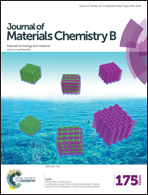Melatonin in functionalized biomimetic constructs promotes rapid tissue regeneration in Wistar albino rats†
Abstract
The development of hybrid scaffolds mimicking the extracellular matrix with bioactive factors has great potential to regenerate tissues in tissue engineering and wound-healing applications. Herein, poly(dialdehyde) gum acacia was synthesized by the selective oxidation of gum acacia and was blended with collagen and melatonin to fabricate biomimetic hybrid scaffolds. The inclusion of poly(dialdehyde) gum acacia improved the stability of collagen and immobilized the melatonin in the hybrid scaffolds. The prepared hybrid scaffolds showed significant biocompatibility when cultured with the Swiss 3T6 mouse fibroblast cell lines in vitro. When subjected to open excisional skin wounds in Wistar albino rats in vivo, the collagen–poly(dialdehyde) gum acacia–melatonin hybrid scaffolds accelerated re-epithelialization and collagen deposition. The results indicate that the melatonin-immobilized hybrid scaffold promotes rapid tissue regeneration and wound repair owing to its antioxidant and anti-inflammatory properties, thereby demonstrating its potential for application in burns and chronic wounds.


 Please wait while we load your content...
Please wait while we load your content...